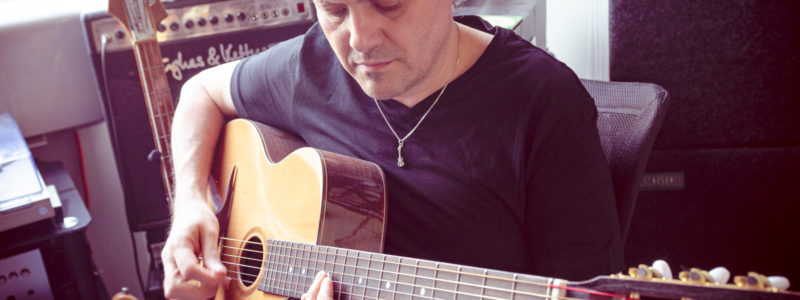
Manouche (gypsy jazz) Guitar Lessons
Manouche (gypsy jazz)Guitar
Gypsy jazz (also known as gypsy swing or hot club jazz) is a style of jazz music generally accepted to have been started by the gypsy guitarist Jean “Django” Reinhardt in and around Paris in the 1930s. This is an area of personal interest that I have been studying and can teach to interested students.
Rhythm
Rhythm guitar in gypsy jazz uses a special form of strumming known as “la pompe”, i.e. “the pump”. This form of percussive rhythm is what gives the music its fast swinging feeling, as it emphasises beats two and four; a vital feature of swing. The strumming hand must make a quick up-down strum followed by a down strum. The up-down part of la pompe must be done extremely fast, regardless of the tempo of the music.
Harmony
Another important aspect of this style of playing is based on the chord shapes Django was forced to use due to his injury in a fire in his caravan. Standard barre chords are not as common in gypsy jazz. Standard major and minor chords are almost never played, and are instead replaced by major 7th chords, major 6th chords, and 6/9 chords. Gypsy reharmonisation is often aimed at giving a minor feel even where a song is in a major key, for instance the substitution of a minor 6th chord for a dominant seventh. Dominant seventh chords are also altered by lowering the 9th and 13th scale degree.
Lead
Lead playing in this style has been summarised as ornamented or decorated arpeggio. Decorations often introduce chromaticism—for instance, mordents and trills. Particularly characteristic is a figure where successive notes of an arpeggio are each preceded by an appoggiatura-like grace note one semitone below. Other decorations include tremolo, string bends, staccato, ghost notes, harmonics, octaves, and double stops etc.
Commonly used scales, in addition to arpeggios, include the chromatic scale, melodic minor scale, dorian mode and diminished scale.
Repertoire
Gypsy jazz has its own set of frequently played standards, which are fairly distinct from the standards tunes of mainstream jazz. However, contemporary ensembles may adapt almost any type of song to the style.
Gypsy swing standards include jazz hits of the ’20s and ’30s, such as “Limehouse Blues”, and “Dinah”; Bal Musette numbers, often waltzes; original compositions by Django Reinhardt, such as “Nuages” and “Swing 42”; compositions by other notable gypsy swing players; and jazzed-up versions of gypsy songs, such as “Dark Eyes”.
Much of the repertoire is in minor keys, and the dorian and harmonic minor modes are frequently heard, lending a distinctively dark and modal sound to the tunes which contrasts with the uptempo and spirited performance style. One popular example is Django’s tune “Minor Swing”, perhaps the most well-known gypsy jazz composition. Slower ballads and duets may feature rubato playing and exotic harmonies.
Maccafferri Guitar
Manouche is usually played on a special kind of guitar called a Maccafferri which can be seen in the image above however the style can be played on any steel string guitar.